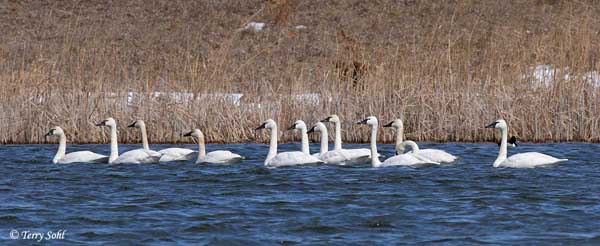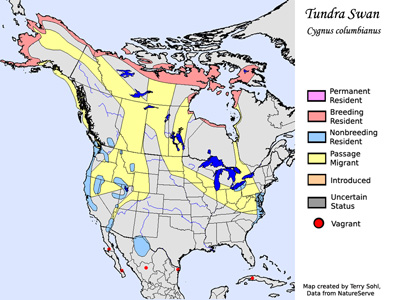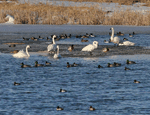| Length: 48 to 58 inches | Wingspan: 6 to 7 feet | Seasonality: Migrant |
| ID Keys: All white body, black bill, yellow spot in front of eye, large size | ||
 Well-named, the Tundra
Swan spends its summer months on tundra lands in or near the Arctic. The
North American race is often called the "Whistling Swan", while the
Eurasian race is often called "Bewick's Swan". This is the most
widespread and common of the swans normally found in North America.
Well-named, the Tundra
Swan spends its summer months on tundra lands in or near the Arctic. The
North American race is often called the "Whistling Swan", while the
Eurasian race is often called "Bewick's Swan". This is the most
widespread and common of the swans normally found in North America.
Habitat: Its summer breeding grounds are the lakes and ponds of the North American tundra. During migration and the winter months, is most often found on shallow lakes, ponds, and estuaries, often in the vicinity of agricultural fields.
Diet: Primarily feeds on the seeds, roots, and stems of aquatic plants. Will also eat large amounts of waste grain in harvested fields, as well as the occasional small invertebrate.
Behavior: Forages both on land and in the water. In the water, forages by swimming on the surface and either grabbing food items from the surface, or by dipping its head and neck below the water for good. As with some other waterfowl species, they have learned to take advantage of waste grain left behind in agricultural fields, and will rely heavily on such food sources during migration and in winter.
Breeding: Non-breeder in South Dakota
Song: Tundra Swan Song
Migration: Summers on the tundra in northern Canada and Alaska. Winters in scattered locations in the west, along the Pacific and Atlantic coastlines, and elsewhere.
Interactive eBird map: Click here to access an interactive eBird map of Tundra Swan sightings
Similar Species: Trumpeter Swan, Mute Swan
Conservation Status: Numbers stable, possibly increasing. Overall, they are found across a broad geographic area and are common in parts of their range. The IUCN considers the Tundra Swan to be a species of "Least Concern".
South Dakota "Hotspot": The northeastern part of the state, especially in and around Sand Lake, are prime locations to find Tundra Swans in migration.
Further Information: 1) Patuxent Bird Identification InfoCenter, Tundra Swan
2) Audubon Guide - Tundra Swan
Photo Information: March 23rd, 2006 -- Minnehaha County -- Terry Sohl
Additional Photos: Click on the image chips or text links below for additional, higher-resolution Tundra Swan photos.
| Click on the range map for a higher-resolution view |
 |
| South Dakota Status: Common migrant in the eastern part of the state, with highest concentrations in the northeast. Accidental in the western part of the state. |
Additional Tundra Swan Photos
Click for a higher-resolution version of these photos


